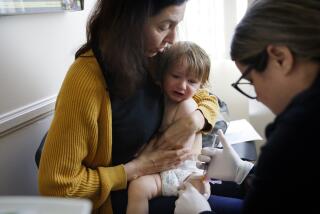2 shots may be better than one for measles, mumps, rubella and chicken pox
- Share via
Children who receive a single vaccine that protects against measles, mumps, rubella and chicken pox appear to have an increased risk of fever-related seizures in the days after the shot than do children who receive two separate vaccinations.
A combination vaccine that protects against measles, mumps, rubella and varicella (commonly known as chicken pox) was approved for use in 2005, providing an option for parents who wanted to stick one fewer needle in their small children. Since then, parents could choose either that single vaccine, called measles-mumps-rubella-varicella, or two separate shots, one for measles-mumps-rubella and one for varicella.
A new analysis from the Kaiser Permanente Vaccine Study Center, however, shows that the four-illness combination vaccine doubles the risk of a fever-related seizure among 1- and 2-year-old children seven to 10 days after the shot.
According to the study, the risk of a child having a fever-related seizure is low — less than one per 1,000 vaccine injections — and is even less common than fever-related seizures linked to colds or respiratory infections. Among children 6 months to 5 years old, 5% will have a fever-related seizure.
But parents should nonetheless be aware of the risk, said the lead author of the study, Dr. Nicola Klein, co-director of the center, who also hoped to put the risk in perspective.
“Febrile seizures are very frightening to parents. But they are benign and don’t cause any long-term problems for the child,” Klein said.
The study, released online Monday in the journal Pediatrics, analyzed data from the nationwide Vaccine Safety Datalink on 459,000 children 12 months to 23 months. The system was established to monitor the safety of newly approved vaccines.
The analysis showed that the combination MMRV vaccine caused one additional febrile seizure for every 2,300 doses administered. The risk of seizure was highest eight to 10 days after the vaccination. Outpatient visits to the doctor for fever also increased during days seven to 10 after the MMRV.
The traditional measles-mumps-rubella shot has long been known to increase the risk of fever. And earlier studies on the combined MMRV vaccine showed it raised the risk of post-vaccine fevers and rashes even further. However, there had been no indication of an increased risk of fever-related seizures.
Based on preliminary data from the study, federal health authorities in May changed vaccine recommendations to allow parents the option of giving their children the MMRV or the traditional MMR plus a separate varicella injection. Parents who opt for the MMRV should be advised about the increased risk of seizure, Klein said. Children whose parents are indifferent about the choice should receive the two separate vaccines, according to the federal recommendations.
The Centers for Disease Control and Prevention recommends vaccination for measles, mumps, rubella and varicella for children between 12 months and 15 months. A booster shot is given between 4 and 6 years old.






